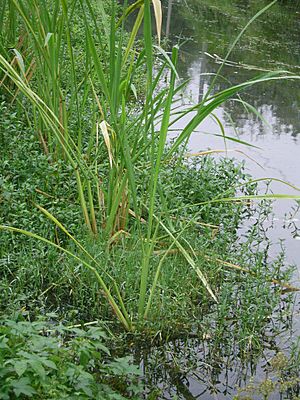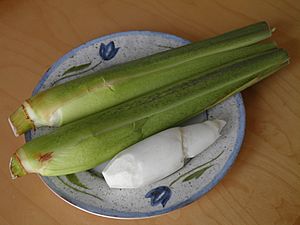Zizania latifolia facts for kids
Quick facts for kids Zizania latifolia |
|
|---|---|
 |
|
| Scientific classification | |
| Genus: |
Zizania
|
| Species: |
latifolia
|
| Synonyms | |
|
|
Zizania latifolia, also called Manchurian wild rice, is a unique plant. It's the only type of wild rice that grows naturally in Asia. People use this plant for food. Both its stems and grains can be eaten.
Long ago, Manchurian wild rice was a very important grain in ancient China. It grows in wet places, like marshes. Today, you don't often find it growing wild. People also don't eat its grain much anymore in Asia. However, they still grow it for its tasty stems. This plant was once so popular that a common Chinese family name, Jiǎng, comes from it!
How Manchurian Wild Rice Grows
People grow Zizania latifolia as a crop all over Asia. This plant needs a special helper to grow well. This helper is a tiny fungus called Ustilago esculenta.
Unlike other wild rice plants, this one is not grown for its grain. Instead, it's grown for its stems. When the fungus infects the plant, the stems swell up. They become juicy and delicious. The fungus makes the plant's cells grow much bigger.
Because of the fungus, the plant cannot make flowers or seeds. So, new plants are grown from its underground stems, called rhizomes. New sprouts get infected by tiny fungus spores in the air. This usually happens in a paddy field, which is a wet field for growing rice.
The swollen stems are harvested as a vegetable. In China, it's called Chinese: 茭白; pinyin: jiāobái. In Japan, it's known as makomotake. The part of the stem that swells is about 3 to 4 centimeters (1 to 1.5 inches) wide. It can be up to 20 centimeters (8 inches) long.
People have been growing this vegetable for at least 400 years. They love its flavor and soft texture. You can eat it raw or cooked. It tastes a bit like fresh bamboo shoots. It stays nice and crisp when you stir-fry it.
The main time to harvest these stems is from September to November. This is often when big storms, like typhoons, hit parts of Asia. During this time, many other vegetables are hard to find. This makes Manchurian wild rice even more popular with shoppers.
Manchurian Wild Rice in New Places
Sometimes, plants are moved to new places by accident. When they grow too much and cause problems, they are called an invasive species. Manchurian wild rice has accidentally started growing wild in New Zealand. There, it is seen as an invasive plant. It has also been brought to Hawaii.
To protect the wild rice plants in North America, it is not allowed to bring these stems into the United States. This rule helps stop the fungus from spreading to other wild rice species.



